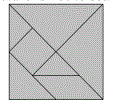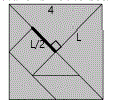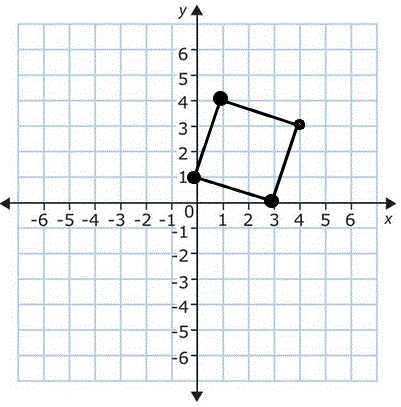 1) A tangram puzzle has 7 shapes that can be put together to make a square as shown. If the side of the large square measures 4 inches, what is the area of the small square? 1) A tangram puzzle has 7 shapes that can be put together to make a square as shown. If the side of the large square measures 4 inches, what is the area of the small square? |
 Use the Pythagorean theorem.
Use the Pythagorean theorem.
1. If you can find the length of a side of the small square you can determine it's area.
2. The length of a side of the small square is half the length of the adjacent side (call it "L") of the large right triangle whose hypotenuse is 4 inches (the outer edge length).
3. Since the other 2 sides of the large triangle are the same, determine the length of one of those sides:
Then L2 + L2 = 42.
4. Solve this for L =
2L2 = 16
L2 = 8
L = √8
5. Take half of that = √8 / 2
6. The area of the small square is (√8 )2 / 4 =
8/4 = 2 sq. in.
|
 2) Rita wants to draw a square on a coordinate graph that's rotated a little bit around its center. She puts one vertex at (2, -1), one vertex at (-1, 0), and one vertex at (0, 3). Where will the last vertex go to complete the square? Use the coordinate graph provided.
2) Rita wants to draw a square on a coordinate graph that's rotated a little bit around its center. She puts one vertex at (2, -1), one vertex at (-1, 0), and one vertex at (0, 3). Where will the last vertex go to complete the square? Use the coordinate graph provided.
|
1. Plot the 3 points on the graph.
2. Determine the offset of the second point (0,1) from the first (3,0). This is going from point 2 to point 1.
The offset is (3,-1).
3. Apply this offset from the third point (1,4) to get the coordinates of the 4th point =
(1 + 3 = 4,4 - 1 = 3) = (4,3)
|